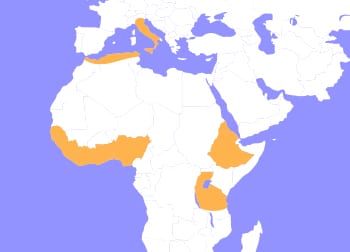Crested Porcupine
Hystrix cristata
Say hello to the largest rodent in Africa. These prickly rodents inhabit hilly, rocky areas across sub-Saharan Africa, ranging to the northern tip of the continent. The range of these porcupines also extends to parts of Europe in Italy. Crested porcupines are considered Least Concern on the IUCN Red List, so they are not endangered. However, in Africa, they eat cultivated crops and are considered agricultural pests. They are also killed for their quills, which are culturally considered ornaments, talismans, and medicine. They are hunted by local farmers using dogs, and smoked out of their burrows; sometimes it has been known that farmers will illegally use poison to kill them.
Crested porcupines have 3 tiers of defense when confronted by a predator. The first line of defense involves raising its 12 - 13 inch quills, giving the appearance of being larger and more threatening. If this doesn’t work, the porcupine will stamp its feet, click its teeth, and rattle its hollow-tipped tail quills. If neither of these strategies chases off the predator, it runs backwards, ramming the attacker with its thick quilled backside. Tips of the quills will lodge into the predator, resulting in wounds that can disable movement or even kill.
Monogamy is a mating trait of these porcupines. Females usually have one litter per year after a gestation period lasting about 112 days, which can deliver 1 - 4 offspring. “Porcupettes” (baby porcupines) are born with open eyes and developed teeth; they also have soft quills upon birth which harden in about a week. Elaborate burrows are dug to house the family group, made up of an adult pair and their young.
Say Hello To Cub Creek's Porcupines: Stanley, Spike, and Poppy
Spike came to us in 2005 as a baby, so he has grown up here at the ranch. Spike loves visiting with our campers and getting lots of ear scratches. Stanley is especially special in our eyes! Stanley was born June 30th of 2015 to Spike and Poppy and was bottle raised by our animal care team. Stanley is a spikey “dog” who loves to cuddle and get ear scratches. Poppy came to us one month old in 2014. She is a spunky and great mother. She has cared for many litters of babies from singles to twins and even triplets. Poppy enjoys seeing our campers every year and getting her favorite treats from them, friend chips.

Crested Porcupines are native to Africa and Middle Eastern countries like Israel. Since their discovery, they've been transported throughout the United States and Europe.
HABITAT -Cape porcupines inhabit hilly, rocky areas across Africa, living in elaborate burrows.
DIET -They are omnivorous, eating bulbs, roots, bark; occasionally eating insects and small vertebrates.
FUN FACT -These porcupines will travel up to 9mi or 15 km in a night searching for food!
SOCIAL BEHAVIOR -While social, they live a monogamous life with one mate, and their offspring.
ACTIVITY -Cape porcupines are nocturnal, foraging for food at night. They rest during the day.
PREDATORS - Natural predators include lions, leopards, hyenas, some large birds of prey, and humans.
SIZE -They are 2-3 ft long, not counting their 3-6 inch tail. Weighing between 20-70 lbs.
RELATIVES -Genus Hystix contains 8 subgenera of porcupines, all related to the Cape porcupine.
CONSERVATION -Crested porcupines are considered LC (Least Concern) according to the IUCN.
Cub Creek Animal Care Information
Housing - Our porcupines are housed in large outdoor enclosures, with access to indoor shelter. They love to explore and are good at climbing up and down stairs, ramps, and low tree branches in their enclosures. Their indoor enclosures are bedded with shavings, while the outside is the bare ground. Our porcupines live in the outdoor portion of our "Lemur Island" building, and indoors in a specialized Habitat enclosure.
Diet - Our porcupines enjoy a nice varied diet of fruits, vegetables, and supplementary dry food (range cubes and rabbit pellets) to give them a well balanced diet. They love to eat apples (served to them whole!), large sweet potato chunks, and greens. Their large incisor teeth help them to crunch through these large pieces of food. We’ll also give them special treats like dried fruits, celery, and other greens.
Enrichment - We provide our porcupines with plenty of enrichment to keep them stimulated and healthy. To help keep their incisors and molars in good health, wood blocks and large cardboard pieces are provided to chew on. In their natural habitat they will also burrow tunnels for shelter, which we simulate in our outdoor enclosures. Heavy balls have also been found to be good enrichment! They love to roll them around and play with them.


